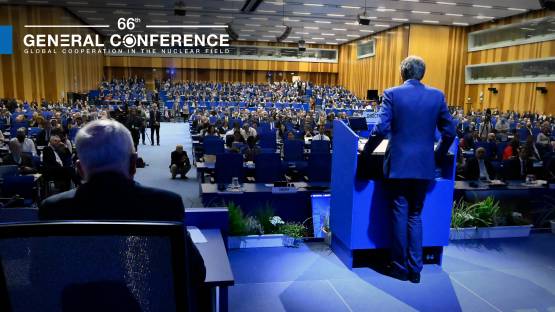The global shift towards increasingly favourable attitudes about nuclear power was on display this week at the IAEA’s 66th General Conference in Vienna, where a record number of countries officially recognized its key role in addressing current global challenges and achieving goals such as climate change mitigation, energy security and sustainable development.
Of 140 national statements delivered at the General Conference, 50 Member States plus the 27-nation European Union favourably cited nuclear power. In addition to positive statements delivered by countries that already use nuclear power, many others came from Member States which do not have nuclear power within their energy mix, particularly Africa.
“The climate crisis and the energy crisis have prompted more countries to look to nuclear power as part of the solution, with public opinion polls all over the world showing an increasing acceptance rate for it,” IAEA Director General Rafael Mariano Grossi said in his statement at the start of the weeklong conference from 26 to 30 September. “The unique attributes of nuclear power as a safe, secure and reliable energy source are crucial to the world’s green transition,” he added.
In their national statements, major nuclear power operating countries such as China, France, Japan, South Korea, the United States of America and Russia all made favourable mention of nuclear power as a reliable and low carbon energy source. “China is committed to building a clean, low-carbon, safe and efficient modern energy system, and regards nuclear energy as an important option to achieve the goal of carbon peaking and carbon neutrality,” said the national statement by China, which currently has 18 nuclear reactors under construction—the most in the world.
A list of national statements under country names that spanned the alphabet—from Algeria to Zimbabwe—underscored the growing appeal of the benefits of nuclear power among developing and middle-income countries.
Besides the 32 countries that already use nuclear power, around 30 other so-called newcomers are either embarking on or consider adding it to their energy mix. The IAEA works closely with newcomers in supporting their development of the infrastructure—including safety and regulatory frameworks and human resources development—needed for a safe, secure and sustainable nuclear power programme. The Agency carries out this work through its Milestones Approach, including the Integrated Nuclear Infrastructure Review (INIR) mission, which supports countries in assessing the status of their nuclear infrastructure.
Several countries from Asia to Africa have hosted INIR missions in recent years. Bangladesh, for example, hosted an INIR mission in 2016 and is now well advanced in the construction of its first nuclear power plant, which it hopes will help drive a national plan to become a developed economy by 2041.
“Nuclear energy plays an integral role in low-carbon energy transitions,” Bangladesh said in its national statement to the 66th General Conference. “Bangladesh considers nuclear energy as an important component of future energy generation mix.” The country’s new nuclear power plant—featuring two 1200 MW(e) reactors— “is moving fast towards its final shape”, the statement added.
Nuclear power currently provides around 10 per cent of the world’s electricity and 25 per cent of its low carbon electricity. This week, for a second successive year, the IAEA revised up its annual projections of the potential growth of nuclear power during the coming decades, reflecting a shift in the global debate over energy and the environment amid growing concerns over energy security and climate change.
These issues will be front and centre next month when government ministers, officials and global experts come together at the IAEA International Ministerial Conference on Nuclear Power in the 21st Century. The conference, hosted by the United States of America, will take place in Washington DC on 26-28 October.
The IAEA is also gearing up to take part in the United Nations Climate Change Conference (COP27), to be held in November in Egypt, which is also building its first nuclear power plant. For the first time in its history, the IAEA will have its own nuclear themed pavilion at the COP27 to shine a light on the role of nuclear in climate mitigation and adaptation. Member States and partners are encouraged to hold events at the IAEA-led #Atoms4Climate Pavilion on a range of topics. On the energy side, these could include the role of nuclear energy in providing affordable low carbon electricity; strengthening resilience to energy systems; ensuring affordable, secure and reliable energy supply; and how nuclear and renewable energy can partner to decarbonize and stabilize future energy systems.
For example, Finland believes that “nuclear energy and renewable energy sources are not mutually exclusive,” the country said in its national statement to the General Conference. “We have a long tradition in the use of nuclear power” and “we have in our energy mix one of the highest shares of renewables in Europe,” the statement added. “Our goal is to make Finland carbon neutral by 2035. To get there, we need CO2-free energy sources.”






